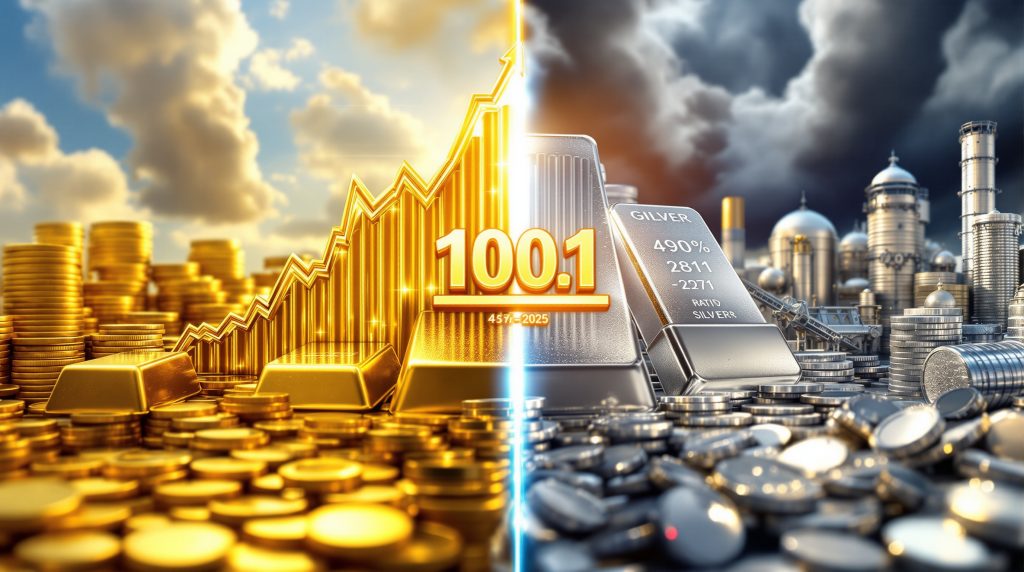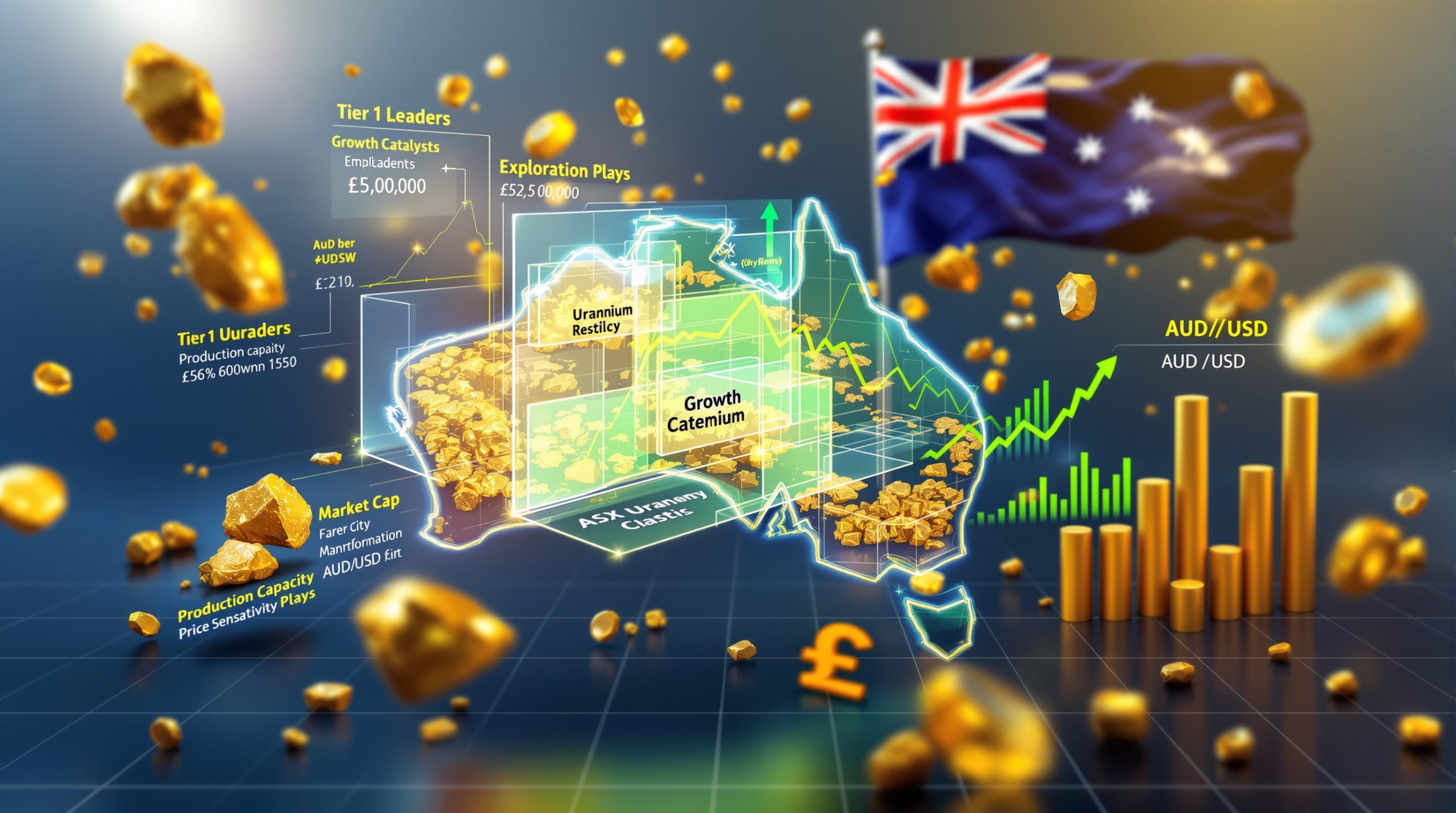Gold vs Silver: A Comprehensive Performance Comparison (1999-2025)
While both considered precious metals, gold and silver follow distinctly different price patterns due to fundamental market differences and economic roles. This analysis examines their performance trajectories since 1999, revealing fascinating patterns of convergence and divergence that can inform investment strategies.
What Drives the Different Price Behaviors of Gold and Silver?
Gold and silver markets differ significantly in size, demand composition, and economic responses, creating their unique price behaviors. Understanding these differences provides valuable insight into why these metals perform differently across market cycles.
Market Fundamentals That Shape Price Movement
The gold market substantially exceeds the silver market in size. According to the World Gold Council, total above-ground gold stocks were approximately 208,874 tonnes as of 2022, valued at approximately $12.7 trillion. By comparison, the Silver Institute reported total above-ground silver stocks at approximately 2.5 million tonnes.
In value terms, the annual gold market is approximately $250 billion, while the silver market is roughly $25-30 billion annually, making silver's market approximately 1/10th the size of gold. This size difference creates significantly different market dynamics when capital flows into or out of each metal.
Demand Sources & Applications
The demand profiles for these metals differ substantially:
- Industrial demand accounts for approximately 50-60% of annual silver consumption, compared to only 7-10% for gold
- Investment demand represents approximately 25-30% of silver demand and 40-50% of gold demand
- Jewelry demand constitutes approximately 45-50% of gold demand but only 15-20% of silver demand
These differences create distinct market responses to economic conditions. Silver's substantial industrial component makes it more sensitive to manufacturing activity and economic growth, while gold's primary investment role makes it more responsive to monetary policy, inflation expectations, and geopolitical tensions.
Economic Response Patterns
Historical data reveals different economic sensitivities between these metals:
- Gold typically shows negative correlation with the US dollar (correlation coefficient of -0.3 to -0.5) and positive correlation with inflation concerns
- Silver shows higher correlation with industrial production indices (correlation coefficient of 0.4-0.6 with global manufacturing PMI)
- Silver exhibits approximately 1.5 to 2 times the volatility of gold on average
According to research from the Perth Mint, silver's smaller market capitalization means that equivalent dollar inflows create proportionally larger price movements compared to gold, contributing to silver's characteristic higher volatility during both uptrends and downtrends.
How Have Gold and Silver Performed Since 1999?
The 25+ year comparison reveals two distinct major market cycles with dramatically different performance characteristics. This historical perspective provides context for understanding current market dynamics.
Setting the Analytical Framework
This analysis uses 1999 as a baseline year for several important reasons:
- Gold averaged approximately $279 per ounce in 1999
- Silver averaged approximately $5.30 per ounce in 1999
- The 1999 baseline represents near-historic lows for both metals following the Bank of England gold auctions and the Washington Agreement on Gold
Using percentage gains from a fixed baseline allows direct comparison of relative performance independent of absolute price levels, which is standard practice in commodity performance analysis.
The analysis identifies two major market cycles:
- 2001-2011: Characterized by quantitative easing post-2008 financial crisis and sovereign debt concerns
- 2016-present: Characterized by geopolitical uncertainty, pandemic stimulus, and inflation concerns
What Happened During the 2001-2011 Precious Metals Supercycle?
The first major cycle of the 21st century saw both metals deliver exceptional returns, though with notable differences in timing and magnitude.
Early Cycle Momentum (2001-2008)
Both metals began a sustained price appreciation in the early 2000s, driven initially by dollar weakness, emerging market growth, and increasing commodity demand. The early years showed relatively parallel performance, with gold maintaining a modest lead in percentage terms from the 1999 baseline.
The 2008 financial crisis initially triggered a sharp but brief selloff in both metals as investors liquidated positions across all asset classes. However, this quickly reversed as unprecedented monetary stimulus programs were announced.
Key Economic Catalysts
Several factors contributed to the remarkable performance during this period:
- The Federal Reserve's balance sheet expanded from approximately $870 billion in August 2007 to over $2.8 trillion by end of 2011 through quantitative easing programs
- US national debt increased from $5.8 trillion in 2001 to $14.8 trillion in 2011
- European sovereign debt crisis heightened currency debasement concerns
- Emerging market central banks became net purchasers of gold after decades of selling
Peak Performance Period (2009-2011)
In the latter part of the cycle, particularly from 2009 to 2011, silver's price appreciation dramatically accelerated, ultimately outpacing gold:
- Gold reached its 2011 peak at $1,895 per ounce on September 5, 2011
- Silver reached its 2011 peak at $48.70 per ounce on April 28, 2011
This performance represented extraordinary gains from the 1999 baseline:
- Silver: +1,126% from 1999 baseline by 2011 peak
- Gold: +660% from 1999 baseline by 2011 peak
Silver's explosive appreciation in the final 24 months (2009-2011) saw it gain approximately 450% from its 2008 low to its 2011 peak. This acceleration coincided with extraordinary investment demand growth, with silver ETF holdings growing from approximately 10,000 tonnes in 2009 to over 18,000 tonnes by 2011.
Volatility During Price Peaks
The volatility differences between the metals became pronounced during this period:
- Silver's annualized volatility reached approximately 40-45% during 2010-2011
- Gold's volatility peaked at approximately 20-25% during the same period
This divergence in volatility reflects silver's smaller market size, which creates more dramatic price swings when investment flows accelerate.
Why Has the Current Cycle (2016-2025) Shown Different Patterns?
The current precious metals cycle has demonstrated a reversal of the previous relationship, with gold consistently outperforming silver – a stark contrast to the 2001-2011 period.
Current Cycle Performance Metrics
The current cycle shows a significant performance gap favoring gold:
- Gold: +491% from 1999 baseline (as of October 2024)
- Silver: +271% from 1999 baseline (as of October 2024)
This creates a stark divergence from the previous cycle's pattern, with gold maintaining a substantial lead in percentage terms throughout the current uptrend. As of late 2024, gold traded above $2,600 per ounce multiple times, representing all-time highs, while silver traded in the $28-34 range, well below its 2011 peak.
Market Structural Changes
Several fundamental shifts help explain the performance divergence in the current cycle:
Central Bank Purchasing Patterns
One of the most significant changes in the gold market has been extraordinary central bank demand:
- Global central banks added approximately 1,136 tonnes of gold to reserves in 2022, the highest annual purchase since 1967
- Central bank gold purchases continued at approximately 1,037 tonnes in 2023
- Central banks hold virtually no silver in reserves, focusing exclusively on gold
This unprecedented central bank demand has created consistent buying pressure in the gold market that has no parallel in silver.
Shifting Industrial Demand for Silver
Silver's industrial demand profile has evolved:
- Solar panel demand for silver reached approximately 140 million ounces in 2023, representing significant growth from approximately 50 million ounces in 2010
- However, this growth has been partially offset by thrifting (reducing silver content per panel) and weaker demand in traditional sectors like photography
Evolution of Investment Sentiment
Investment flows show diverging patterns:
- Gold ETF holdings reached approximately 3,200 tonnes in early 2024, showing strong institutional support
- Silver ETF holdings declined from their 2021 peak of approximately 37,000 tonnes to approximately 26,000 tonnes by late 2024, indicating weaker investment demand
According to analysis from Metals Focus, the divergence in performance between gold and silver in the current cycle reflects gold's enhanced role as a geopolitical hedge and currency alternative, while silver faces headwinds from substitution in industrial applications and weaker investment sentiment.
What Explains the Performance Differences Between Gold and Silver?
Understanding the fundamental differences between these metals provides insight into their divergent price behaviors across different market environments.
Demand Profile Comparison
The demand composition for each metal creates different market dynamics:
Gold Demand (2023 data):
- Jewelry: 47% (approximately 2,093 tonnes)
- Investment: 29% (bars, coins, ETFs – approximately 1,292 tonnes)
- Central banks: 23% (approximately 1,037 tonnes)
- Technology: 7% (approximately 296 tonnes)
Silver Demand (2023 data):
- Industrial: 48% (approximately 530 million ounces)
- Jewelry: 18% (approximately 203 million ounces)
- Investment: 22% (physical bars and coins – approximately 237 million ounces)
- Silverware: 5% (approximately 53 million ounces)
- Photography: 3% (approximately 28 million ounces)
This demand composition means silver faces a dual nature – part industrial commodity, part investment asset – while gold functions primarily as a monetary and investment asset. When industrial demand weakens during economic downturns, silver often experiences greater price pressure than gold, which may simultaneously benefit from safe-haven flows.
Gold's Monetary Role vs. Silver's Dual Nature
Gold's status as a tier-1 capital asset for banks under Basel III regulations (effective 2019) has enhanced institutional demand, while silver lacks this regulatory support. This monetary role is further reinforced by central bank holdings:
- Gold is held by central banks worldwide with total official gold reserves exceeding 36,000 tonnes
- Silver is not held in meaningful quantities as monetary reserves by any major central bank
Market Size and Liquidity Factors
The substantial size difference between gold and silver markets creates different liquidity and volatility characteristics:
- Total above-ground gold value: approximately $13-14 trillion at 2024 prices
- Total above-ground silver value: approximately $1.4-1.5 trillion at 2024 prices
- Ratio approximately 10:1 in value terms
Trading Volume Disparities
Daily trading volumes highlight significant liquidity differences:
- Daily trading volume in gold futures (COMEX): approximately 20-30 million ounces ($50-75 billion value)
- Daily trading volume in silver futures (COMEX): approximately 150-200 million ounces ($4-7 billion value)
Despite higher ounce volume in silver futures, gold's dollar-denominated liquidity is significantly higher. This creates different market dynamics, with silver experiencing more dramatic price moves when faced with equivalent dollar flows.
Volatility Implications
The London Bullion Market Association notes that silver's industrial demand creates different price dynamics, with approximately 50% of demand being relatively price-inelastic (industrial requirements) while the remaining 50% (investment and discretionary) is highly price-sensitive. This creates inherently higher volatility in silver markets compared to gold.
How Does the Gold-to-Silver Ratio Reflect Historical Relationships?
The gold-silver ratio analysis provides a critical metric for understanding relative valuation between the metals and has historically offered insights into potential future performance.
Historical Ratio Analysis
The gold-to-silver ratio has fluctuated widely over time:
- Long-term average (20th century): approximately 47:1 to 50:1
- Ratio in 1999: approximately 53:1 ($279 gold / $5.30 silver)
- Peak ratio reached March 2020: approximately 123:1 during COVID-19 market panic
- Ratio in April 2011 (silver peak): approximately 31:1
As of late 2024, the gold-to-silver ratio traded in the 80-90:1 range, significantly higher than long-term historical averages but below the extreme readings seen during the 2020 market panic.
Extreme Ratio Events
The ratio has seen several notable extremes in recent decades:
- All-time high: 123:1 (March 2020, COVID-19 panic)
- Modern era low: approximately 31:1 (April 2011, silver bubble peak)
- Historical low (pre-1900s): approximately 15:1 when both metals circulated as currency
Predictive Value of the Ratio
Research published in Resources Policy journal found that extreme gold-to-silver ratios (above 80:1 or below 40:1) historically preceded corrections toward the mean, though timing of such corrections remained unpredictable.
However, the CPM Group notes that the ratio's long-term average has shifted upward since the 1990s as gold's monetary role strengthened while silver's industrial role increased, suggesting the historical 47:1 average may no longer be the relevant equilibrium.
Mean Reversion Patterns
According to academic research from GoldBullion Australia, the gold-to-silver ratio exhibits mean-reverting properties over multi-year periods, though short-term deviations can be substantial and persistent. This pattern has led some investors to use extreme ratio readings as potential signals for relative value opportunities between the metals.
For investors, the ratio offers a framework for evaluating relative value, though it should be considered alongside broader market fundamentals rather than as a standalone timing indicator.
What Can Investors Learn From These Performance Patterns?
The historical performance comparison offers valuable insights for portfolio construction and investment timing decisions.
Portfolio Allocation Considerations
The different characteristics of gold and silver create distinct portfolio roles:
Volatility Management Strategies
Historical volatility metrics highlight important risk considerations:
- Standard deviation of annual returns (2000-2023):
- Gold: approximately 18-20%
- Silver: approximately 30-35%
- S&P 500: approximately 18-20%
These volatility differences suggest different optimal allocation sizes, with typically smaller allocations to silver due to its higher volatility profile.
Correlation Benefits During Economic Stress
The metals offer different diversification benefits:
- Gold shows negative correlation with equities during market stress periods (approximately -0.2 to -0.4 during major drawdowns)
- Silver correlation with equities is higher (approximately 0.3 to 0.5), reducing its safe-haven characteristics
This correlation pattern means gold typically provides better portfolio protection during equity market drawdowns, while silver may perform better during inflationary growth environments.
Cyclical Investment Timing
Understanding the different cycle behaviors of gold and silver can help investors with timing decisions:
Identifying Cycle Inflection Points
Historical patterns suggest several potential signals for cycle changes:
- Extreme readings in the gold-to-silver ratio
- Significant shifts in monetary policy (tightening or easing)
- Changes in industrial demand outlook for silver
- Central bank purchasing patterns for gold
Economic Indicators That Signal Metal Preference
Different economic environments have historically favored different metals:
- Periods of strong economic growth combined with inflation concerns have typically favored silver (as seen in 2009-2011)
- Periods of economic uncertainty, geopolitical tension, and currency concerns have typically favored gold strategic investment (as seen in the current cycle)
- Deflationary environments have historically been challenging for both metals, though gold has typically shown greater resilience
Understanding these cyclical patterns can help investors adjust their precious metals allocations based on the prevailing economic environment and cycle position.
How Might Future Economic Conditions Impact Gold vs. Silver Performance?
Current economic trends suggest potential shifts in the relative performance of these metals, with several key factors likely to influence their trajectory.
Supply-Demand Outlook
Both metals face evolving supply and demand dynamics:
Mining Production Forecasts
- Gold production has plateaued in recent years, with few major new discoveries and declining ore grades at existing mines
- Silver production is heavily tied to base metal mining (approximately 70% of silver is produced as a byproduct), creating supply dynamics linked to industrial metal demand
Industrial Demand Projections
Silver faces both opportunities and challenges in industrial applications:
- Renewable energy demand (particularly solar panels) continues to grow, supporting silver consumption
- Electronics miniaturisation and thrifting (reducing silver content) create offsetting pressures
- Emerging technologies like 5G infrastructure and electric vehicles provide potential new demand sources
Investment Flow Predictions
Investment demand remains a critical variable for both metals:
- Gold continues to benefit from strong central bank demand and growing interest from institutional investors
- Silver investment demand has been more volatile, with significant ETF outflows in recent years
- Retail investor interest in physical metal has remained relatively robust for both gold and silver
Macroeconomic Impact Assessment
Several macroeconomic factors will likely influence the metals' performance:
Inflation Scenario Analysis
Persistent inflation concerns could benefit both metals, though historical patterns suggest different responses:
- Moderate inflation (3-5%) has typically supported both metals
- High inflation (>5%) has historically created stronger percentage gains for silver
- Deflation has generally been negative for both metals, though less severe for gold
Currency Debasement Implications
Concerns about fiat currency stability continue to drive interest in precious metals analysis:
- Central bank balance sheet expansion and sovereign debt growth create long-term support for gold
- Fiscal deficits and currency debasement concerns potentially benefit both metals
- Changes in reserve currency status or composition could significantly impact gold demand
Geopolitical Risk Factors
Geopolitical tensions and international monetary system changes create additional variables:
- De-dollarisation efforts by various nations support central bank gold demand
- Regional conflicts increase safe-haven demand, typically benefiting gold more directly
- Trade tensions impact silver's industrial demand component
FAQ: Gold and Silver Performance Comparison
What causes silver to be more volatile than gold?
Silver's smaller market size and significant industrial demand component create greater price sensitivity to both economic cycles and investment flows. With a market roughly 1/10th the size of gold, equivalent capital movements produce more dramatic price effects in silver. Additionally, silver's dual role as both industrial commodity and precious metal creates more complex supply-demand dynamics that contribute to price volatility.
When has silver historically outperformed gold?
Silver typically outperforms gold during periods of strong economic growth combined with inflation concerns, as seen during 2009-2011 when silver gained 1,126% from the 1999 baseline compared to gold's 660%. This outperformance occurs when both industrial and investment demand accelerate simultaneously. Silver also tends to outperform during the latter stages of precious metals bull markets, often experiencing more dramatic percentage gains than gold.
Why has gold outperformed silver in the current market cycle?
Gold's outperformance since 2016 (+491% vs. silver's +271% from the 1999 baseline) reflects stronger central bank purchasing, persistent geopolitical uncertainties, and weaker industrial demand for silver during periods of economic uncertainty. Gold's primary role as a monetary asset has proven advantageous in the recent economic climate characterized by currency concerns, geopolitical tensions, and significant monetary expansion by central banks.
What does the current gold-to-silver ratio indicate about future performance?
The elevated gold-to-silver ratio (approximately in the 80-90:1 range as of late 2024) suggests silver may be historically undervalued relative to gold based on long-term averages. Historically, such elevated ratios have often preceded periods of silver outperformance as the ratio reverts toward long-term means. However, structural changes in both markets may have shifted the equilibrium ratio higher than historical averages, and timing of any reversion remains unpredictable.
How do economic conditions affect the relative performance of gold and silver?
Economic expansion typically favours silver due to increased industrial demand, while economic contraction often benefits gold as investors seek safe-haven assets. Inflation concerns can drive both metals higher, though silver often shows greater percentage gains during inflationary periods. Monetary policy changes, particularly shifts toward easing or tightening, can significantly impact both metals, with easing typically more supportive of price appreciation.
Conclusion
The 25-year performance comparison between gold and silver reveals two distinct major market cycles with dramatically different characteristics. The 2001-2011 cycle ultimately saw silver deliver extraordinary outperformance, while the current cycle since 2016 has favored gold consistently. This divergence reflects fundamental changes in central bank purchasing patterns, industrial demand profiles, and investment sentiment.
Understanding the different market structures, demand compositions, and economic sensitivities of these metals provides valuable insight into their divergent performance patterns. While both metals serve as stores of value and inflation hedges, their different characteristics create distinct investment cases and portfolio roles.
For investors, this historical perspective offers important context for allocation decisions, highlighting how different economic environments may favor one metal over the other. The gold price forecast provides an additional framework for evaluating relative value, though it should be considered alongside broader market fundamentals.
As economic conditions continue to evolve, both metals are likely to remain important components of diversified portfolios, though their relative performance will continue to be shaped by the complex interplay of monetary policy, industrial demand, investment flows, and geopolitical developments.
Disclaimer: This article is for informational purposes only and does not constitute investment advice. Investing in precious metals involves risk, and past performance is not indicative of future results. Readers should conduct their own research and consult with financial advisors before making investment decisions.
Ready to Spot the Next Mining Discovery?
Discover why major mineral discoveries can lead to exceptional returns by exploring Discovery Alert's dedicated discoveries page, where their proprietary Discovery IQ model transforms complex mineral data into actionable investment insights for ASX-listed companies.




